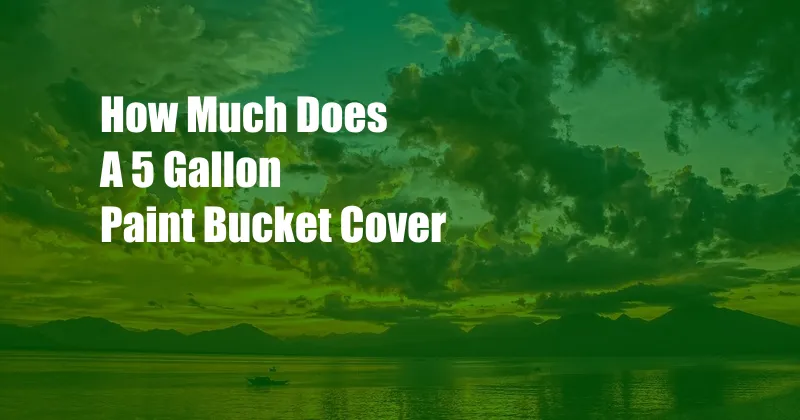
How Much Does a 5-Gallon Paint Bucket Cover?
When tackling painting projects, estimating the amount of paint needed is crucial. A 5-gallon paint bucket is a commonly used size, but its coverage can vary depending on factors such as the type of paint, the surface being painted, and the application method. In this article, we’ll delve into the specifics of how much a 5-gallon paint bucket covers and provide insights to help you plan your painting endeavors efficiently.
Calculating the coverage of a 5-gallon paint bucket requires an understanding of its volume and the concept of square footage. A US gallon is equivalent to 231 cubic inches or approximately 3.785 liters. Therefore, a 5-gallon paint bucket contains approximately 1892.5 cubic inches or 18.93 liters of paint.
Coverage Calculation
To calculate the coverage of a 5-gallon paint bucket, we need to consider the “spread rate” of the paint. Spread rate is typically expressed in square feet per gallon and varies depending on the type of paint and the surface being painted. For instance, a typical latex paint may have a spread rate of 350-400 square feet per gallon, while an oil-based paint may have a spread rate of 250-300 square feet per gallon.
Using a latex paint with a spread rate of 350 square feet per gallon as an example, a 5-gallon paint bucket would provide coverage for approximately 1750-2000 square feet. However, it’s essential to note that this is just an estimate. The actual coverage may vary based on the porosity of the surface, the number of coats applied, and the application method.
Factors Affecting Coverage
- Paint Type: Different types of paints have varying spread rates. Latex paints typically have higher spread rates compared to oil-based paints.
- Surface Texture: Rough or porous surfaces require more paint to achieve adequate coverage compared to smooth surfaces.
- Number of Coats: Multiple coats of paint increase the overall coverage and provide better opacity.
- Application Method: Spraying paint generally provides better coverage compared to rolling or brushing.
Tips for Accurate Coverage Estimation
To ensure accurate coverage estimation, consider the following tips:
- Consult the Paint Label: The paint can label typically includes the spread rate information, which provides a good starting point for coverage calculation.
- Calculate Surface Area: Measure the length and width of the surfaces to be painted, then multiply these dimensions to find the square footage.
- Adjust for Overlap: When painting multiple coats, consider adding a 10-15% overlap to account for any missed spots or uneven application.
- Factor in Surface Condition: If the surface is rough or porous, increase the estimated coverage by 10-20%.
FAQ
- Q: How many square feet does a 5-gallon paint bucket typically cover?
A: Approximately 1750-2000 square feet for latex paint with a spread rate of 350-400 square feet per gallon. - Q: What factors affect the coverage of a paint bucket?
A: Paint type, surface texture, number of coats, and application method. - Q: How can I estimate the coverage needed for a painting project?
A: Calculate the surface area, adjust for overlap, and consider the surface condition and paint type. - Q: Is it better to buy more paint than needed?
A: It’s recommended to purchase slightly more paint than estimated to avoid running short during the project. - Q: How can I store leftover paint?
A: Store leftover paint in a cool, dry place, and ensure the lid is tightly sealed to prevent drying.
Conclusion
Understanding how much a 5-gallon paint bucket covers is essential for efficient paint project planning. By considering the spread rate of the paint, the surface being painted, and the application method, you can make informed decisions about the quantity of paint needed. Employing accurate coverage estimation techniques will help you avoid costly over-purchases while minimizing the likelihood of running out of paint during the project.
Are you curious about learning more about painting techniques, paint types, or color selection? Let us know your queries, and we’ll be happy to provide additional insights and resources to enhance your painting endeavors.